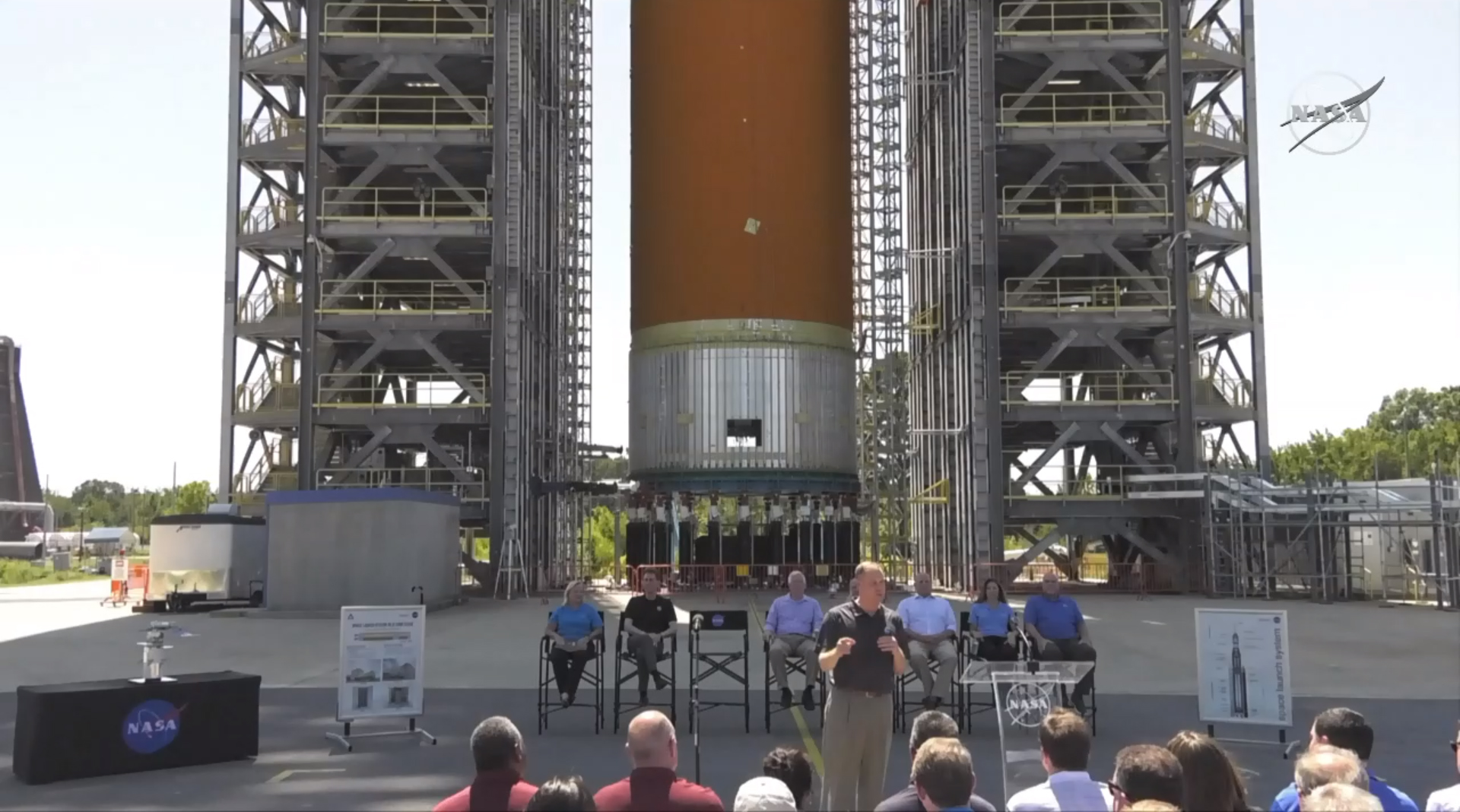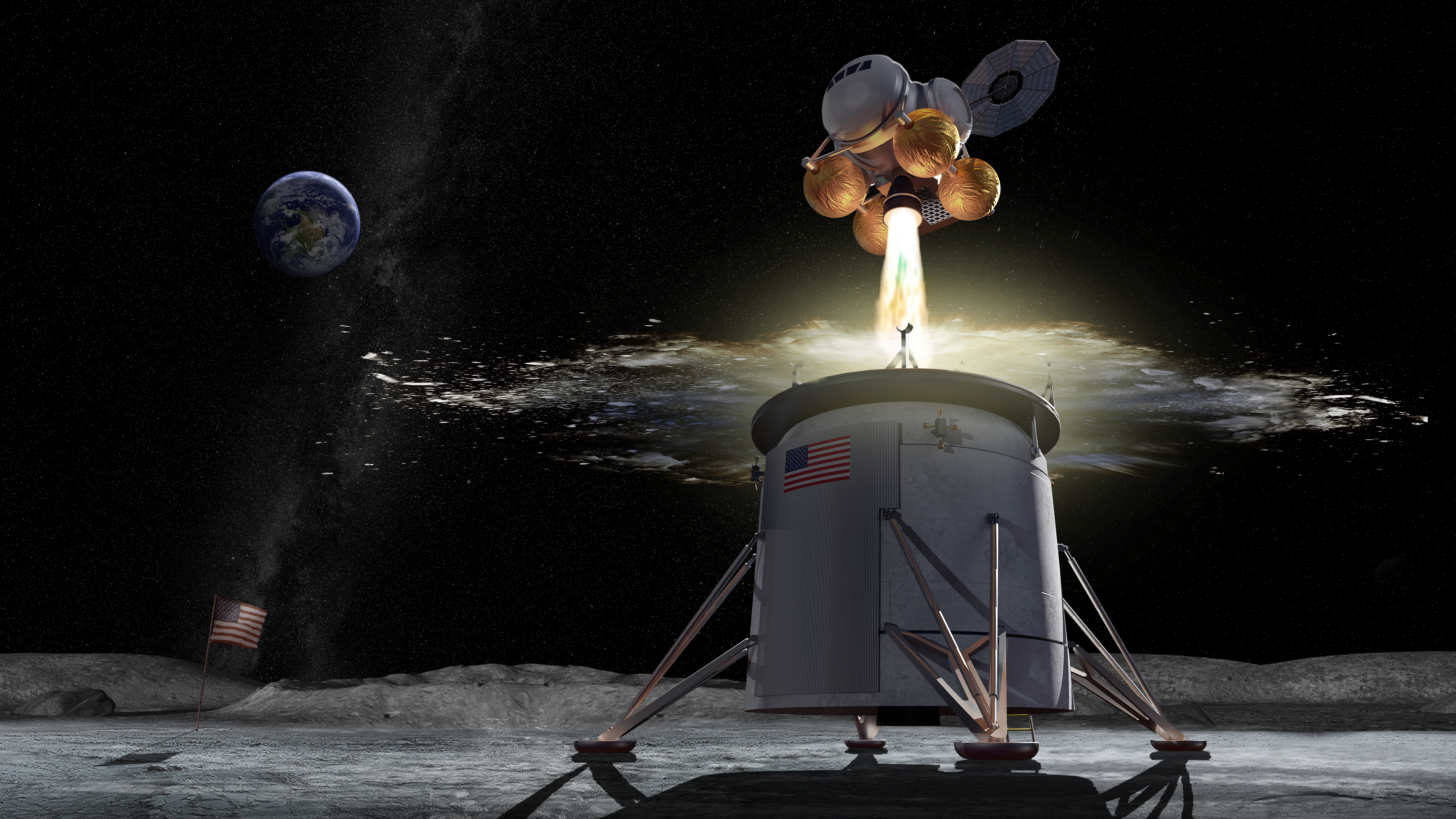NASA's Artemis Moon Lander for Astronauts Will Be Born in Alabama's 'Rocket City'
The lunar lander that will bring astronauts to the moon in 2024 will be born in Alabama's "Rocket City," NASA announced today (Aug. 16).
NASA's Marshall Space Flight Center (MSFC) in Huntsville will lead the development of a lunar lander for the agency's Artemis program, which aims to land astronauts on the moon in 2024. Huntsville is known as "Rocket City" due to its long history of building rockets for NASA. MSFC is also currently building the Space Launch System megarocket that will launch NASA's Artemis missions.
According to NASA Administrator Jim Bridenstine, the center was selected to be in charge of the lunar lander because of its extensive experience with propulsion systems, which will be crucial for executing safe landings and liftoffs from the lunar surface.
"There is no place in the world that is more experienced" in propulsion, Bridenstine said during a news briefing at the center. As he spoke, Bridenstine stood in front of a massive 149-foot-tall (45 meters) structural test component for the Space Launch System, which will stand about 322 feet tall (98 m) when fully assembled.
Related: Can NASA Really Put Astronauts on the Moon in 2024?


While local representatives who were present for the announcement seemed pleased to have this historic undertaking take place in Alabama, not everyone was thrilled about the announcement. Lawmakers in Texas have been pressuring NASA to let the Johnson Space Center (JSC) in Houston lead the lunar lander development.
On Thursday (Aug. 15), Senators Ted Cruz (R-Texas) and John Cornyn (R-Texas) along with Rep. Brian Babin (R-Texas) wrote an open letter to Bridenstine explaining why JSC, which leads NASA's human spaceflight program, should be in charge of the lunar lander, too.
Breaking space news, the latest updates on rocket launches, skywatching events and more!
When asked about the controversy, Bridenstine said that all NASA centers across the country will play important roles in the Artemis program, adding that MSFC's propulsion experience made that center the best candidate for this aspect of the program. The lunar lander project is expected to create 360 new jobs, 140 of which will be in Huntsville, while the rest will be spread out to NASA centers across the country, Rep. Mo Brooks (R-Ala.) said during the news conference.
Bridenstine also announced that the new human landing system will be managed by Lisa Watson-Morgan, the former Deputy Engineering Director of MSFC. A "Rocket City" native who has worked her way up the ranks at MSFC for the last 15 years, Watson-Morgan will oversee the project that will land "the first woman and the next man on the moon," Bridenstine said.
Although MSFC will be leading the development of the lander, its construction won't necessarily take place inside the facility. NASA's private industry partners will likely play a role in building the various components of the lander.
"What we plan to do is collaborate with industry and bring their speed and our experience to try to have the best team that can make this 2024 goal," Watson-Morgan said.
Today's new development in the Artemis program comes nearly three months after NASA announced three commercial companies that will carry the first uncrewed missions to the lunar surface. Those missions will deliver NASA science experiments, technology demonstrations and other payloads to the moon in preparation for the crew landing in 2024.
NASA has also picked the company Maxar Technologies to build the propulsion module for the space agency's new Lunar Gateway, a space station near the moon designed to serve as a transportation hub for trips to and from the lunar surface.
- NASA Aims to Accelerate SLS Megarocket for 2024 Moon Push
- These Are the Private Lunar Landers Taking NASA Science to the Moon
- NASA Awards $45.5 Million for Private Moon Lander Work on Project Artemis
Follow us on Twitter @Spacedotcom and on Facebook.

Hanneke Weitering is a multimedia journalist in the Pacific Northwest reporting on the future of aviation at FutureFlight.aero and Aviation International News and was previously the Editor for Spaceflight and Astronomy news here at Space.com. As an editor with over 10 years of experience in science journalism she has previously written for Scholastic Classroom Magazines, MedPage Today and The Joint Institute for Computational Sciences at Oak Ridge National Laboratory. After studying physics at the University of Tennessee in her hometown of Knoxville, she earned her graduate degree in Science, Health and Environmental Reporting (SHERP) from New York University. Hanneke joined the Space.com team in 2016 as a staff writer and producer, covering topics including spaceflight and astronomy. She currently lives in Seattle, home of the Space Needle, with her cat and two snakes. In her spare time, Hanneke enjoys exploring the Rocky Mountains, basking in nature and looking for dark skies to gaze at the cosmos.
